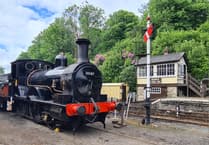IMAGINE for a moment what an 88-year-old vehicle looks like. In car terms, if you had an 88-year-old vehicle on the road, today, you could be driving a Morris Eight, containing a dizzying 23.5 bhp in its 918cc side valve straight-four engine.
The skies above you would be more likely to contain Boeing B-17 Flying Fortress heavy bomber aircraft than air traffic taking holiday makers to Pathos, Peru or Pyongyang; for 88 years ago, it would have been July 1935.
You’d certainly be more likely to see either vehicle or the hundreds of equivalents from that era in a museum than transporting paying passengers between two destinations.
While most of the railway network was taking the early, nascent steps into the plan to eliminate the Victorian locomotion of steam for the clean, modern diesel equivalent (how times change), things were a bit different on the Bodmin and Wadebridge Railway.
Trains until 1962 were mostly operated using LSWR 0298 class trains, known as Beattie Well Tanks, of which 85 had been produced between 1863 and 1875 for use originally on the suburbs of London, before later becoming used on rural services in the South West of England.
All but three of these locomotives had become life-expired, surplus to requirements and withdrawn from service before the turn of the 20th century, having been replaced in favour of more modern steam locomotives between 1888 and 1898.
It was in 1893 that three locomotives of the 0298 class first made their way to the Bodmin and Wadebridge line with the aim of replacing the ancient, worn-out and increasingly unreliable Fletcher Jennings 0-4-0 saddle tanks that arrived on the line in 1864.
While you might have expected that these new-to-Cornwall locomotives would have come to Bodmin by rail for their new working lives, such was the detached nature of the Bodmin and Wadebridge Railway, they were required to be sent by sea to Wadebridge for the North Cornwall Railway, which would connect it with the rest of the network would not arrive until the following year.
Considered as fast runners that handled heavy loads with ease, the reason for the extended life spans of these locomotives on the Bodmin and Wadebridge line came due to the construction of the line, which, while overhauled in the late 1800s, still followed the curves and construction methods of the 1830s. that being with tight curves and lightly laid line of the freight branch line to the Wenford clay dries.
Across their 64 year lifespan on the line, they were the only locomotives considered suitable for the job, with their design lending themselves succinctly to the nature of the line.
Attempts to replace them came, and went, with failure. In 1929, a trial of cascaded SECR P Class 0-6-0 tank engines, built between 1909 and 1910, namely locomotive number 558 (scrapped in 1960), ended abruptly after the locomotive was found to damage the railway tracks during operation due to being unable to cope with the tight curves on the line. This led to the reprieve of a previously condemned engine, 329 (later renumbered 30586).
The locomotive’s eventual replacement in 1962 came as part of another coincidence. Three uniquely built, but considerably more modern (having been built in 1934) constructed former GWR 0-6-0 small pannier tank engines, numbered 1367, 1368 and 1369, had become redundant around the docks of Weymouth in 1962.
Two of the LSWR 0298 engines made their way into preservation and until more recent years, one, 30587, was based at the very railway line it had called home for many years with the Bodmin and Wenford heritage railway.
After its withdrawal in 1962 after completing 1,289.348 miles in operation, it was selected for preservation by the National Railway Museum and initially stored at Fratton Shed in Portsmouth, before later arriving on loan at the Dart Valley Railway at Buckfastleigh in 1978.
A Bodmin resident and long-time benefactor of Bodmin and Wenford Railway, the late Alan Moore, sponsored the restoration of 30587 and its former running mate 30585 in the early 2000’s with a condition of the funding being that the engines would spend time at the Bodmin and Wenford railway.
After leaving Bodmin and Wenford Railway in 2017, 30587 was identified as one of a group of five engines that could provide passenger train lines at the railway museums in York, Shildon and Manchester.
However, in August 2019, it was taken out of service after a technical failure and it is currently remains non-operational. It can be seen as a static exhibit at the National Railway Museum, located in York.



.png?width=209&height=140&crop=209:145,smart&quality=75)

Comments
This article has no comments yet. Be the first to leave a comment.